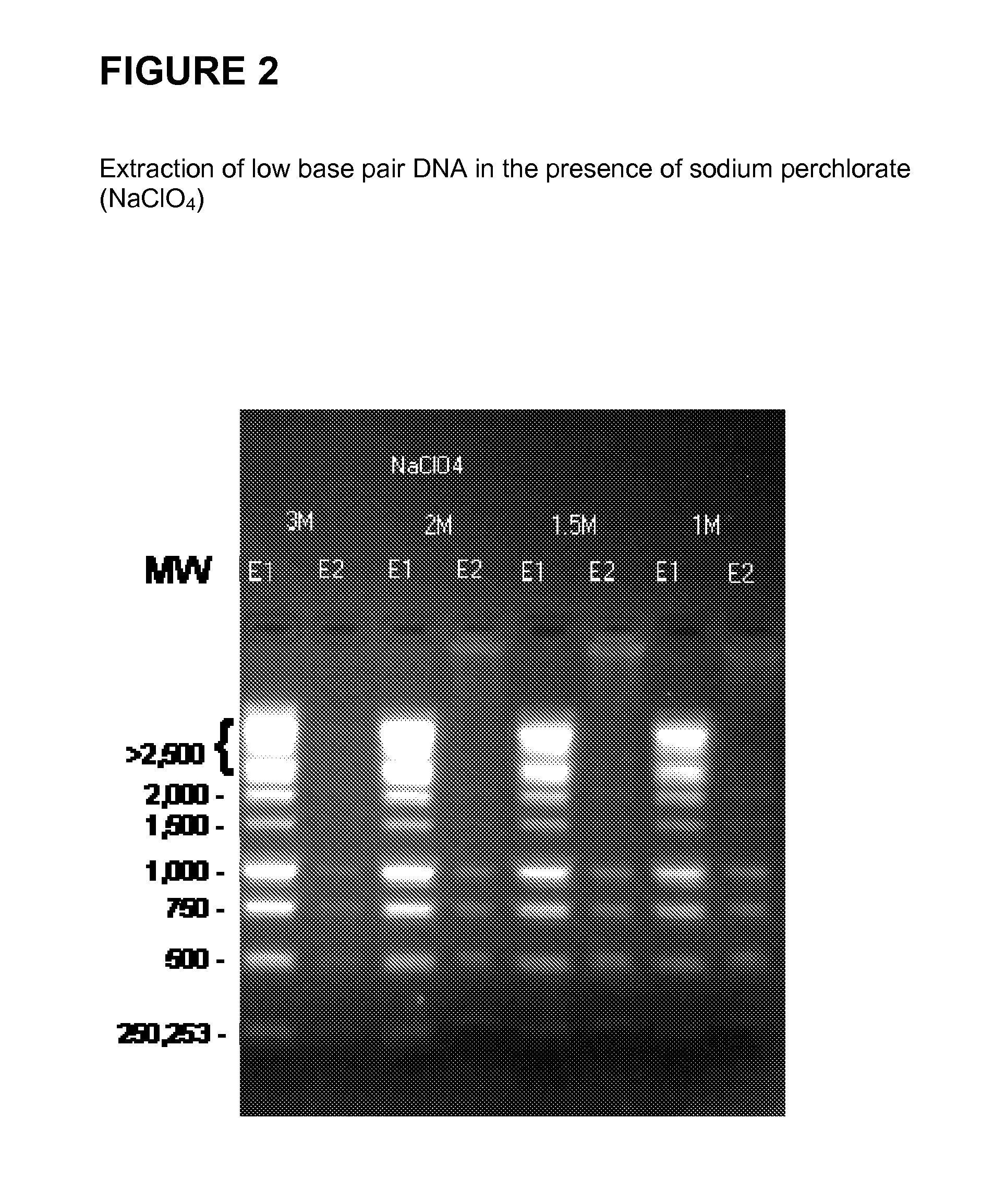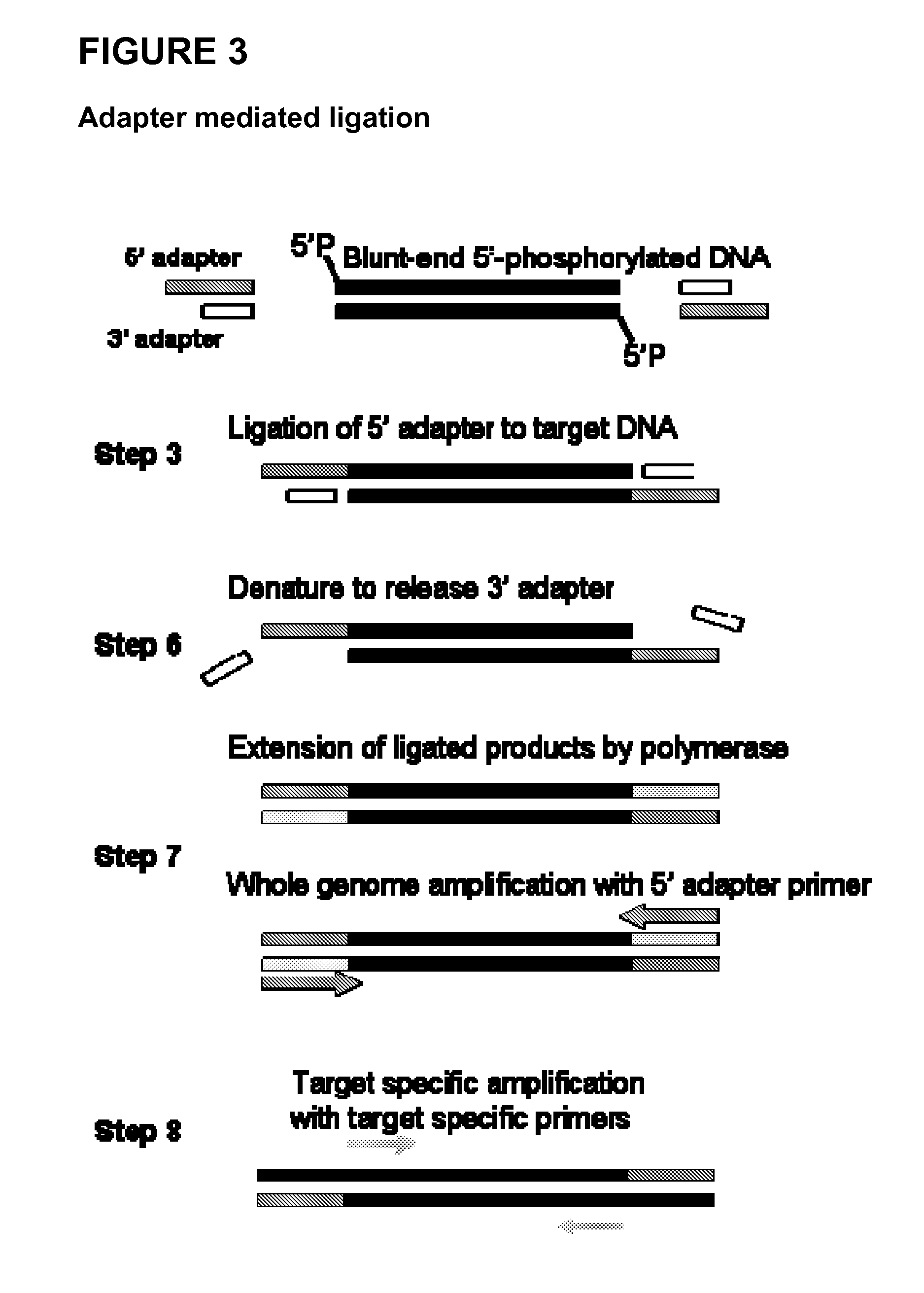Methods and compositions for the extraction and amplification of nucleic acid from a sample
a nucleic acid and extraction method technology, applied in the field of methods and compositions for the extraction and amplification of nucleic acid from samples, can solve the problems of requiring considerable experimental effort, complex process, and high cost, and achieve the effect of simple and cost-effectiv
- Summary
- Abstract
- Description
- Claims
- Application Information
AI Technical Summary
Benefits of technology
Problems solved by technology
Method used
Image
Examples
example 1
Isolation of DNA Using a Double Extraction Salt-Based Method
[0102]The example provides a procedure, using a method provided herein, to selectively extract DNA based on its size.
[0103]1. Protein denaturation and protein digestion
[0104]Add a low concentration of chaotropic salt, for example, less than 30% solution (weight per volume) to the sample solution to denature proteins and inactivate nucleases, proteinase K or any protease, for example 100 to 1000 μg) to further inactivate nucleases and break down proteins in solution. Alternatively, detergents, for example SDS or Triton-X 100 up to 1% volume per volume, may be used alone or in combination with a salt.
[0105]Mix the solution thoroughly, and incubate for 10-30 minutes at 55° C., or sufficient time and temperature for the enzyme in use.
[0106]2. Binding of non-target nucleic acid
[0107]Add a low concentration of salt, for example, 10-30% weight per volume, and add the solid support.
[0108]Mix the solution thoroughly, and incubate 10...
example 2
DNA Extraction in the Presence of Guanidine Thiocyanate (GuSCN)
[0125]FIG. 1 shows the successful extraction of low base pair DNA from a 1 kb DNA ladder (Promega™) in the presence of guanidine thiocyanate (GuSCN). The DNA is first bound to silica at various low concentrations of guanidine thiocyanate as shown in FIG. 1. The supernatant from the first binding solution is subsequently bound to silica at varying guanidine thiocyanate concentrations, with a finishing high concentration of 4.6M. These steps are followed by wash and elution steps.
[0126]The method can be employed to produce size selective separation of a commercially available DNA ladder with DNA strands ranging in mass from 250 bp to 10,000 bp from normal human plasma in the presence of guanidine thiocyanate as the chaotropic salt. The following steps are performed:
[0127]1. To four separate vessels, add 10 μL protease solution (20 ug / μL), 200 μL normal human plasma, and 100 μL 4.5 M GuSCN (final concentration 1.45 M).
[0128...
example 3
DNA Extraction in the Presence of Sodium Perchlorate (NaClO4)
[0136]FIG. 2 shows the successful extraction of low base pair DNA from a 1 kb DNA ladder (Promega™) in the presence of sodium perchlorate (NaClO4). The DNA is first bound to silica at various low concentrations of sodium perchlorate as shown in FIG. 2. The supernatant from the first binding solution is subsequently bound to silica at varying sodium perchlorate concentrations, with a finishing high concentration of 4.5 M. These steps are followed by wash and elution steps.
[0137]The method can be employed to produce size selective separation of a commercially available DNA ladder with DNA strands ranging in mass from 250 bp to 10,000 bp from normal human plasma in the presence of sodium perchlorate (NaClO4) as the chaotropic salt. The following steps are performed:
[0138]1. To four separate vessels, add 10 μL protease solution (20 ug / ul), 200 μL normal human plasma, and 100 μL 4.5 M GuSCN (final concentration 1.45 M).
[0139]2....
PUM
| Property | Measurement | Unit |
|---|---|---|
| temperature | aaaaa | aaaaa |
| concentration | aaaaa | aaaaa |
| concentration | aaaaa | aaaaa |
Abstract
Description
Claims
Application Information
 Login to View More
Login to View More - R&D
- Intellectual Property
- Life Sciences
- Materials
- Tech Scout
- Unparalleled Data Quality
- Higher Quality Content
- 60% Fewer Hallucinations
Browse by: Latest US Patents, China's latest patents, Technical Efficacy Thesaurus, Application Domain, Technology Topic, Popular Technical Reports.
© 2025 PatSnap. All rights reserved.Legal|Privacy policy|Modern Slavery Act Transparency Statement|Sitemap|About US| Contact US: help@patsnap.com



